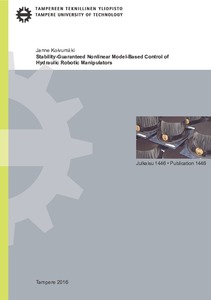Stability-Guaranteed Nonlinear Model-Based Control of Hydraulic Robotic Manipulators
Koivumäki, Janne (2016)
Koivumäki, Janne
Tampere University of Technology
2016
Rakennetun ympäristön tiedekunta - Faculty of Built Environment
This publication is copyrighted. You may download, display and print it for Your own personal use. Commercial use is prohibited.
Julkaisun pysyvä osoite on
https://urn.fi/URN:ISBN:978-952-15-3894-0
https://urn.fi/URN:ISBN:978-952-15-3894-0
Tiivistelmä
Robotics technology is booming and it is projected to dominate in the coming decade. Although robotics has already made a considerable impact on many aspects of modern life, advanced robotics is still in its infancy. However, applications of robots are increasing all the time, and their structures are becoming more complex. This increasing complexity creates new challenges in control design, and with the advent of more advanced and more demanding operations, new solutions for controlling robots are needed.
Hydraulic actuators can benefit robotic systems because, compared to electric actuators, they can produce significant forces and torques for their size. Thus, typical operations with hydraulic robotic systems are contact tasks in which heavy objects are handled or in which forces are generated on the environment (e.g., excavation). However, in contact tasks, the control system stability (which is the primary requirement for all control systems) has drawn considerable attention since the installation of the first industrial robots, and numerous reasons for unstable responses have been identified. One of the most significant reasons for instability is that a robot’s nonlinear dynamics are not considered rigorously. However, rigorously addressing robot dynamics is one of the fundamental challenges in highly nonlinear hydraulic robotic systems, and this issue has also slowed the spread of their closed-loop control solutions. To address the highly nonlinear dynamics of hydraulic robotic systems, nonlinear model-based (NMB) control methods can be used. However, a stability-guaranteed NMB control design for hydraulic robotic systems has remained an open problem in contact tasks.
This thesis studies a high-performance NMB control method for hydraulic robotic manipulators and provides a rigorous solution for the above open problem. In this thesis, a novel subsystem-dynamics-based virtual decomposition control (VDC) approach is used as an underlying control design framework. The unique features of VDC enable the system’s control design and stability analysis at the subsystem level, without imposing additional approximations. This thesis also studies another fundamental challenge of the lack of energy efficiency in hydraulic systems and a force-sensorless contact force estimation for hydraulic robotic manipulators. For energy-efficient control of hydraulic systems, the control design principles of VDC are extended from robotic systems to a broader group of dynamic systems.
This compendium thesis is composed of four publications and one unpublished manuscript. The publications extend the state of the art in the control of hydraulic robotic manipulators in free-space motion and in constrained motion. To provide a possibility for reducing energy consumption, the unpublished manuscript proposes an adaptive and NMB controller for variable displacement axial piston pumps (VDAPPs), whose dynamic behaviour is highly nonlinear in the fourth order, for the first time without using any linearization or order reduction. All control designs in this thesis are stability-guaranteed NMB controls.
Hydraulic actuators can benefit robotic systems because, compared to electric actuators, they can produce significant forces and torques for their size. Thus, typical operations with hydraulic robotic systems are contact tasks in which heavy objects are handled or in which forces are generated on the environment (e.g., excavation). However, in contact tasks, the control system stability (which is the primary requirement for all control systems) has drawn considerable attention since the installation of the first industrial robots, and numerous reasons for unstable responses have been identified. One of the most significant reasons for instability is that a robot’s nonlinear dynamics are not considered rigorously. However, rigorously addressing robot dynamics is one of the fundamental challenges in highly nonlinear hydraulic robotic systems, and this issue has also slowed the spread of their closed-loop control solutions. To address the highly nonlinear dynamics of hydraulic robotic systems, nonlinear model-based (NMB) control methods can be used. However, a stability-guaranteed NMB control design for hydraulic robotic systems has remained an open problem in contact tasks.
This thesis studies a high-performance NMB control method for hydraulic robotic manipulators and provides a rigorous solution for the above open problem. In this thesis, a novel subsystem-dynamics-based virtual decomposition control (VDC) approach is used as an underlying control design framework. The unique features of VDC enable the system’s control design and stability analysis at the subsystem level, without imposing additional approximations. This thesis also studies another fundamental challenge of the lack of energy efficiency in hydraulic systems and a force-sensorless contact force estimation for hydraulic robotic manipulators. For energy-efficient control of hydraulic systems, the control design principles of VDC are extended from robotic systems to a broader group of dynamic systems.
This compendium thesis is composed of four publications and one unpublished manuscript. The publications extend the state of the art in the control of hydraulic robotic manipulators in free-space motion and in constrained motion. To provide a possibility for reducing energy consumption, the unpublished manuscript proposes an adaptive and NMB controller for variable displacement axial piston pumps (VDAPPs), whose dynamic behaviour is highly nonlinear in the fourth order, for the first time without using any linearization or order reduction. All control designs in this thesis are stability-guaranteed NMB controls.
Kokoelmat
- Väitöskirjat [4764]
